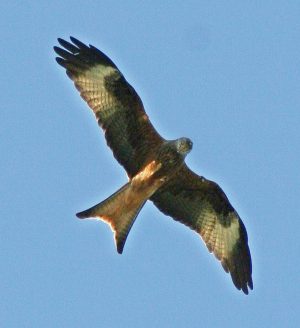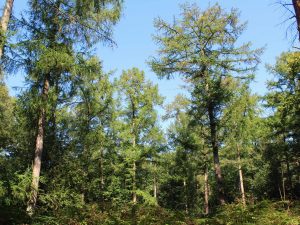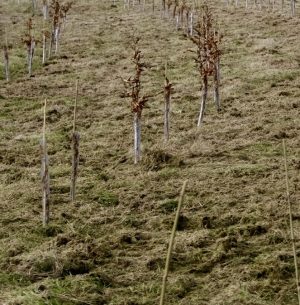Changing forests and woodlands.

For millions of years, forests and woodlands have been changing - as a result of natural regeneration, storms, fires and climate change. However, with the expansion of human populations, woodlands and forests have been cut down to make way for towns, cities and the infra-structure of ‘modern’ life. Sadly forests, and woodlands such as those in the path of HS2, are still disappearing. ‘Untouched’ rain / tropical forest is being cut down to make way for cash crops; plus vast wooded areas have been destroyed by fire in Australia, Sweden and on the West Coast of the United States in recent years.
 Clearfell of any forested area for timber or agriculture involves the removal of all trees / vegetation and is sometimes followed by burning of the remaining debris. Clearfell can also have unintended consequences (beyond the loss of entire animal communities. An Australian study has shown that it lowers soil nutrient levels - notably nitrate and phosphate. Furthermore, the use of heavy machinery in clearfelling can compact the soil and its consequent exposure to the elements can lead to erosion (rain runoff). When an area is subject to intense fire, there is a drop in the organic carbon content of the soil and structural damage to the soil; it can take many years for such fire-damaged soil to ‘recover’.
Clearfell of any forested area for timber or agriculture involves the removal of all trees / vegetation and is sometimes followed by burning of the remaining debris. Clearfell can also have unintended consequences (beyond the loss of entire animal communities. An Australian study has shown that it lowers soil nutrient levels - notably nitrate and phosphate. Furthermore, the use of heavy machinery in clearfelling can compact the soil and its consequent exposure to the elements can lead to erosion (rain runoff). When an area is subject to intense fire, there is a drop in the organic carbon content of the soil and structural damage to the soil; it can take many years for such fire-damaged soil to ‘recover’.
Forests and woodlands support the vast majority of land-based species. However, the species that we see today on a woodland walk may be different to those our ancestors might have seen five hundred or a thousand years ago. Certain species only survive in relatively undisturbed (and ancient) forests / woodlands. There are species that can ‘deal’ with disturbance and are adaptable, indeed opportunitistic, such as red deer and fox. The same can be said for certain plants species, which can become invasive.
Changes in species make-up and biodiversity do not always immediately follow loss of forest or woodland. Generally speaking, the longer the life span of a species then the longer for the effects of forest loss to become apparent.  It may be that the effects ‘span’ generations, raptors / birds of prey may manage to raise their young in the immediate period following loss of forest or woodland. But their offspring may struggle to survive in a depleted environment. It might be that with limited resources an animal might simply not reproduce for years, if ever again. Consequently, the impact of forest destruction / loss that species depletion might not be apparent for many years.
It may be that the effects ‘span’ generations, raptors / birds of prey may manage to raise their young in the immediate period following loss of forest or woodland. But their offspring may struggle to survive in a depleted environment. It might be that with limited resources an animal might simply not reproduce for years, if ever again. Consequently, the impact of forest destruction / loss that species depletion might not be apparent for many years.
The loss of forests and woodlands has lead to many local, national and inter-national initiatives to offset these losses: for example, New Zealand’s ‘One Billion Trees” project and the Nature Conservancy’s “plant a billion trees’ campaign. Broadly speaking, reforestation involves the planting of native trees in an area, whereas planting with new (non-native) species is afforestation.
Recent research suggests  that whilst non-native plants often grow faster than native species, they also have less dense tissues (think: oak versus larch) and decompose more readily, which can contribute to more rapid cycling of carbon. This will not help to mitigate climate change. It is also important to consider which trees might prosper and offer resilience in the light of climate change. Our climate is changing and will be different in the future, with summer temperatures being higher. We have already seen more extreme weather events (leading to flooding and wild fires).
that whilst non-native plants often grow faster than native species, they also have less dense tissues (think: oak versus larch) and decompose more readily, which can contribute to more rapid cycling of carbon. This will not help to mitigate climate change. It is also important to consider which trees might prosper and offer resilience in the light of climate change. Our climate is changing and will be different in the future, with summer temperatures being higher. We have already seen more extreme weather events (leading to flooding and wild fires).
Forestry England has a number of tools to help plan which tree species will be suited to a site, now and in future. There is ESC4 which offers a means to help forest managers and planners select tree species that are ecologically suited to particular sites; and there is also the climate matching tool. As Forestry England says this is “so that we can see which places in the world currently experience the climate we are projected to have in future. We can compare these different places to help us plan which tree species will be suited to a site, now and in future”. One strategy is to create woodlands that are more diverse, as it thought that diversity helps woods more resilient to climate change. This can be through encouraging a range of different, but carefully selected trees to grow, and being aware of the provenance of seeds or saplings.
a number of tools to help plan which tree species will be suited to a site, now and in future. There is ESC4 which offers a means to help forest managers and planners select tree species that are ecologically suited to particular sites; and there is also the climate matching tool. As Forestry England says this is “so that we can see which places in the world currently experience the climate we are projected to have in future. We can compare these different places to help us plan which tree species will be suited to a site, now and in future”. One strategy is to create woodlands that are more diverse, as it thought that diversity helps woods more resilient to climate change. This can be through encouraging a range of different, but carefully selected trees to grow, and being aware of the provenance of seeds or saplings.
Comments are closed for this post.
Discussion
Wherever humans have been throughout the planet we have changed the ecology of the land to suit our then needs with ‘probably’ no thought of any consequences. Only now we seem to have a conscience of what we do, but still I get worried that we always think we know best. By that I mean I read in the above blog that the current thought is to ‘diversify’ planting of trees. Why do we think that we know better than what nature provided for us? If diversify was the answer, wouldn’t nature have provided it already?

Well, Forestry England is essentially talking about new planting (to help deal with elevated carbon dioxide levels, in part). Diversity is thought to promote resilience to
pests
disease and
climate change.
See, for example, https://assets.publishing.service.gov.uk/government/uploads/system/uploads/attachment_data/file/987432/england-trees-action-plan.pdf
Trees such as Beech already being affected by climate change – see https://www.theguardian.com/news/2019/feb/18/weatherwatch-drought-threatens-britain-beech-trees
Plus, probably few people who wish to see the monocultures of conifers created in the past
blogs
28 March, 2022